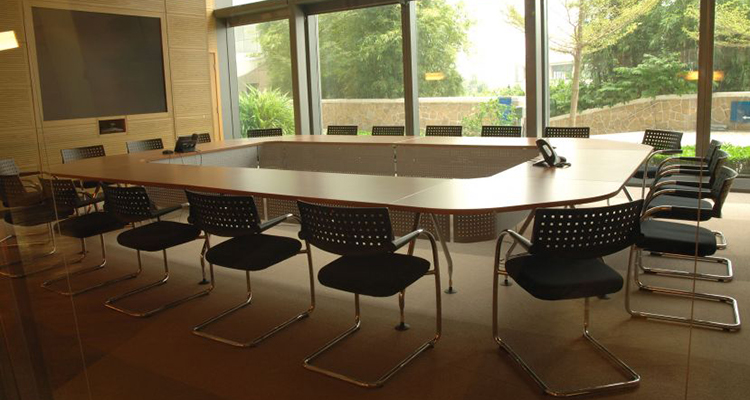InfoComm: Inside the Modern High-Tech Boardroom
 By Cindy Davis
By Cindy Davis
Special to InfoComm International
The traditional boardroom conjures images of mahogany, leather and PowerPoint. Maybe it’s used quarterly, for board meetings of directors from around the globe. For all those other days of the year, the projector, gooseneck microphones and super-slick control panel remain idle.
Not anymore. Today, workplace trends and new technology are transforming almost every aspect of the modern boardroom — and it starts in the office.
“How do you take the experience that an executive has at the desktop, which is seamless audio-videoconferencing integration, and move that same experience through their personal conference room — through any space they may need, up to and including the boardroom?” says Scott Walker, CTS-D, LEED AP, president and CEO of Waveguide.
The executive boardroom is no longer an island unto itself, with its own design rules and gravitational forces. “We need to empower the boardroom to be more like the desktop, which is kind of flipping the whole thing on its head,” Walker says. “How they might share content wirelessly in their own office is the same thing they need to do in their boardroom. It’s a similar look and feel, not a wholly separate experience.”
Consider the trends: Powerful mobile devices, from laptops to smartphones, have become all-in-one offices, allowing users to correspond and collaborate, share information, interact, and gather, store and analyze data. At the same time, organizations are creating new physical environments, such as huddle spaces or other meeting rooms, to facilitate “ideating” between two or more people. Single-use offices are giving way to collaboration areas. Such factors increasingly are the norm in workplace environments. And what applies to the humble huddle space applies to the executive boardroom.
“We no longer take a room or project approach,” says Dale Bottcher, senior vice president for sales and operations at AVI-SPL. “It’s more of a platform approach so it crosses the entire enterprise. The technology has got to be scalable and consistent room-to-room.”
Not an Island
AV professionals say that boardroom design has taken on a holistic approach. Starting from an enterprise-level technology model, new systems and upgrades are migrating into boardrooms as part of an interconnected whole. Today’s boardroom is an integrated, interoperable collaboration space writ large and communication tools are the key.
“Just as organizations have huddle rooms all the way up to boardrooms, people have the expectation that they can bring in a tablet and display or share content in the room,” Bottcher says.
The thing is, depending on use case, some organizations prefer to keep the boardroom simple. And as simple as technology such as unified communications and collaboration (UCC) has become, its introduction to the boardroom may face headwinds. Talking through executives’ needs is important.
When one major corporate client wanted a brighter projector for its boardroom, Bottcher says it was a chance to think ahead. “It’s a very simple design, and the last time it was upgraded was maybe 1995,” he explains. “I said, ‘Let’s think about this a little bit. You’ll need conferencing ability in this space within a year or two. You have a 40-foot wall you’re projecting on. Why not make that a tiled videowall or some form of large display that can be upgraded for videoconferencing or some form of UCC technology?”
Indeed, videowall technology is not just the domain of lobby displays and operations centers. Boardrooms, which are often designed to impress their particular users and enhance decision-making, can also benefit from large visual canvases.
“What we’re seeing, particularly with oil and gas customers, is entire front walls becoming giant videowalls where they can pull up multiple windows of content and look at high-resolution details,” says Walker. And while a large-format display is ideal for presentations, more boardrooms today also require individual screens for meeting participants. “Because it’s not just a PowerPoint being presented to the board,” Walker says. “It is much deeper data analytics that need to be managed, voted on and made a part of the meeting.”
“While large LCD displays are becoming more readily available at reasonable cost, they still have a practical limit on what size space they can serve effectively,” says Gregory Clark, CTS, principal consultant at The Sextant Group. “Once that threshold is crossed, alternate technologies such as projection or a videowall may better suit the application, and those require differing infrastructure provisions.”
For example, some boardrooms opt for rear-projection, specifically. Housing projectors in a separate room removes noise and potential heat from the boardroom, plus it eliminates the threat of shadows on-screen. And depending on budget, the projection room can include a pair of projectors — one for backup duty — so that the meeting can always go on.
The Multipurpose Boardroom
With all the collaboration technology being incorporated into boardrooms, many organizations are trying to maximize the investment year-round. “They’re using the room for more than four days a year,” Walker says. “Other days of the week they may use it for investor calls or other decision-making. It sort of becomes a huddle room on steroids.”
Emerson Process Management recently opened a multipurpose space at its offices in Austin, Texas, to foster collaboration with the company’s partners and accommodate board meetings. Emerson supplies process automation technology to oil and gas, refining, chemicals, life sciences, metals and mining, and power industries. The Integrated Operations Center at Emerson’s Process Systems and Solutions Innovation Center (pictured) has already hosted multiple board meetings, but it’s also a sort of experience center where customers can see how integrated companies streamline decision-making, collaborate across locations and more easily accessible expertise — sort of what a board of directors might do.
“We’ve had really positive reactions from everybody who’s come into the facility,” say Mike Boudreaux, director of performance and reliability monitoring at Emerson. “We have customers who come visit us here in Austin from all over the world, often evaluating not only our products, but also our capabilities and expertise.”
Emerson embraced Barco collaboration technology for the center. In working with Waveguide on the project, the company emphasized usability across all use cases, whether to support board meetings or customer experiences.
“You walk into the room and there’s an on/off button on the wall. You press ‘on’ and the lights and screen come on and the Barco ClickShare is activated,” Boudreaux says. “If you want to do anything more elaborate, we have a tablet to manage it.”
Say What?
As AV professionals know, an effective collaboration space, such as a modern boardroom, is about more than technology. Emerson engaged Waveguide soon after sitting down with the architect and quickly realized that what users hear would be as important as what they see.
“Going into the project we didn’t have a very strong appreciation for the value of good acoustics, and that was something that Waveguide helped us gain an appreciation for,” Boudreaux says.
Working collaboratively with the architect, Waveguide helped shift the room design to be more acoustically pleasing. “We had some unique designs, with rounded rooms and glass walls, and we needed the ability to prevent a lot of ‘fishbowl effect’ echoing,” Boudreaux explains. “We also had to make sure that we had the right microphone placement, lighting and speaker locations. They’re still rounded walls, but they were flattened out a little bit as a result of the acoustic design.”
It can be argued that acoustics and intelligibility are even more important considerations for modern boardrooms as the need to include remote participants in meetings grows. The boardroom at the Calgary, Alberta, headquarters of energy-distribution company Enbridge was in need of expansion and upgrades. Amin Ladha, IT Systems Analyst at Enbridge, recalls that remote participants were complaining they couldn’t hear everyone in the company’s aging boardroom during meetings.
“I’m involved in setting up the executive team meetings, board meetings and any meetings that involve high-level stakeholders,” Ladha says. “That’s where most of the complaints were stemming from. Quite often we had a lot of echoing.”
In addition, as meetings grew, the original 18-seat table wasn’t big enough, leaving 10 or more participants sitting on the periphery, farther away from the table microphones.
When the Enbridge boardroom was renovated, it gained a purpose-built table for 26 and a carefully considered AV design to accommodate 35.
“We put together a design package that showed the polar patterns of the microphones based on the table they were spec’ing for the room,” says Keith Newson, Design Engineer at AVI-SPL Canada. Pop-up mics with intuitive muting and unmuting features minimized the effect of paper shuffling at the table, while ceiling mics in the boundary areas ensured participants not seated around the table could be heard.
“You have to think bigger in a boardroom,” says Waveguide’s Walker. “As boardrooms get larger, you have to do what’s historically been called a mix-minus system so you can amplify voices within the room. There are better and better microphones, DSP algorithms and speakers out there. We’re seeing some interesting products that used advanced technology to focus on the sound you want to hear and disregard the sound you don’t want to hear.”
Of course, in boardroom situations, what executives don’t want people to hear is, well, everything. For privacy’s sake, sound isolation and masking techniques are a must, to say nothing of commonsense design measures to ensure that people who shouldn’t see confidential presentations — through windows or sleek glass walls — don’t.
“Because AV is an enabler,” says Emerson’s Boudreaux. “It’s not the thing in the room; it’s really part of the room.”
This article was reprinted with permission from InfoComm International and originally appeared here.




